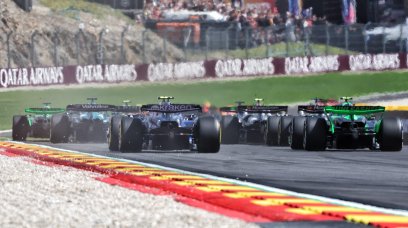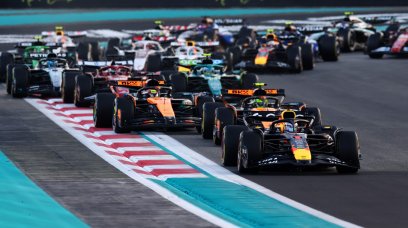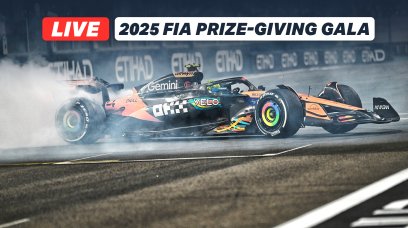In motorsport, there are two FIA-recognised single-seater world championships: Formula 1, and Formula E.
Below the two, there are several recognised junior single-seater categories, but the two closest to the highest-level and receive the most airtime is Formula 2 and Formula 3.
F2 and F3 are the feeder championships for F1, whilst some F2 drivers are starting to move to FE when a switch to the pinnacle of motorsport becomes unavailable.
This year, six drivers from last season's F2 grid have been promoted to either F1 or FE. Gabriel Bortoleto, Isack Hadjar, Kimi Antonelli and Oliver Bearman are the four who have moved to F1, whilst Zane Maloney and Taylor Barnard are now FE drivers.
But how big a difference is there between all the cars, in terms of top speed, power and acceleration?
Viewed by others:
Top Speed
When it comes to top speed, it should come as no surprise that it is F1 that leads the way. Under the championship's current regulations, the cars are capable of an almighty 230 mph.
This is comfortably the quickest FIA single-seater, with F2 claiming second place, courtesy of a top speed of 208 mph.
That is potentially faster than some might expect, whilst FE claims the bronze medal at 200 mph with the current Gen3 EVO car. F3 trails in last, unsurprisingly, with a top speed of 186 mph.
Check out the top speed table below (article continues below the table)...
Top speed
| Position | Category | Top speed (mph) |
|---|---|---|
| 1 | F1 | 230 |
| 2 | F2 | 208 |
| 3 | FE | 200 |
| 4 | F3 | 186 |
Power
Moving onto power, and, again, it is F1 which claims a comfortable victory. F1 cars currently produce around 1,000 bhp, more than double an FE car's 470.
FE again has to settle for third, with F2 being the closest to F1 in regard to the total power produced by its car.
An F2 car is capable of producing 620 bhp, putting it in second. Once again, F3 claims last with its cars only producing 380 bhp.
Check out the power table below (article continues below the table)...
Power
| Position | Category | Power (bhp) |
|---|---|---|
| 1 | F1 | 1,000 |
| 2 | F2 | 620 |
| 3 | FE | 470 |
| 4 | F3 | 380 |
Acceleration
In the final category, the gold medal does not go to F1; in fact, the championship is 30% slower from 0-60 mph than the series which claims top spot.
The fastest accelerating FIA single-seater championship is FE, with its car going from 0-60 mph in just 1.82s.
This is largely thanks to its electrical power, whilst the Gen3 EVO is also the fastest accelerating FIA single-seater in history. F1 is in second, with 0-60 mph being possible in 2.6s.
Interestingly, this is only just quicker than F2, which has cars that achieve 0-60 mph in 2.8s. Completing a clean sweep at the bottom, F3 falls in last place.
Check out the acceleration 0-60 mph table below (article continues below the table)...
Acceleration (0-60 mph)
| Position | Category | 0-60 mph time |
|---|---|---|
| 1 | FE | 1.82s |
| 2 | F1 | 2.6s |
| 3 | F2 | 2.8s |
| 4 | F3 | 3.1s |
Results
So, who comes out as the overall winner? In terms of this article, the winner is the championship which claimed the best position in each category, with a first place being equal to 1 point.
It means that the championship that amassed the fewest points is the victor. To no shock, given its identity as being the pinnacle of motorsport, F1 claims top spot.
F1 is a clear winner, whilst F2 and FE are equal on points in second, with F3 trailing far behind. It does all make sense, with F3 being a series for very young drivers to develop their skills.
A repeat of this comparison will be fascinating in 2026, when both F1 and FE will introduce new regulations, respectively.
Check out the results table below...
Results
| Position | Category | Points |
|---|---|---|
| 1 | F1 | 4 |
| 2 | FE | 7 |
| 2 | F2 | 7 |
| 4 | F3 | 12 |
Also interesting:
Join RacingNews365's Ian Parkes, Sam Coop and Nick Golding, as they look into the six full-time F1 rookies featuring on this year's grid. Who will do the best is discussed, as is who could face an early exit.
Rather watch the podcast? Then click here!
Don't miss out on any of the Formula 1 action thanks to this handy 2026 F1 calendar that can be easily loaded into your smartphone or PC.
Download the calenderMost read












Join the conversation!